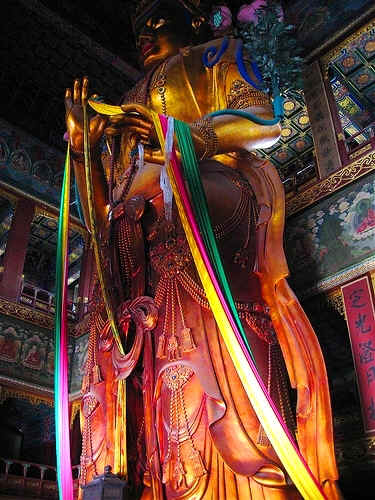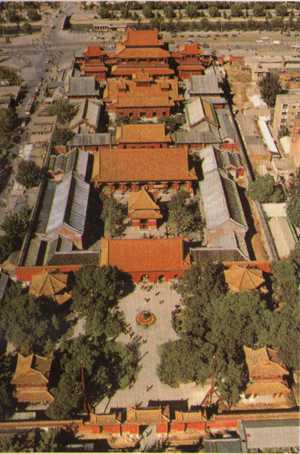
The Lama Temple (雍和宫 in Mandarin Chinese) is the largest Tibetan Buddhist temple in Beijing. Its name means The Temple of Harmony.
Location of the Lama Temple
The Lama Temple is located in the northeast of Beijing at 12 Yonghegong dajie (No. 12 Harmony Temple Avenue), a street oriented north-south. It is served by bus lines No. 13, 116, 62, and 406. The subway also serves the temple at Yonghegong Station.
History of the Lama Temple
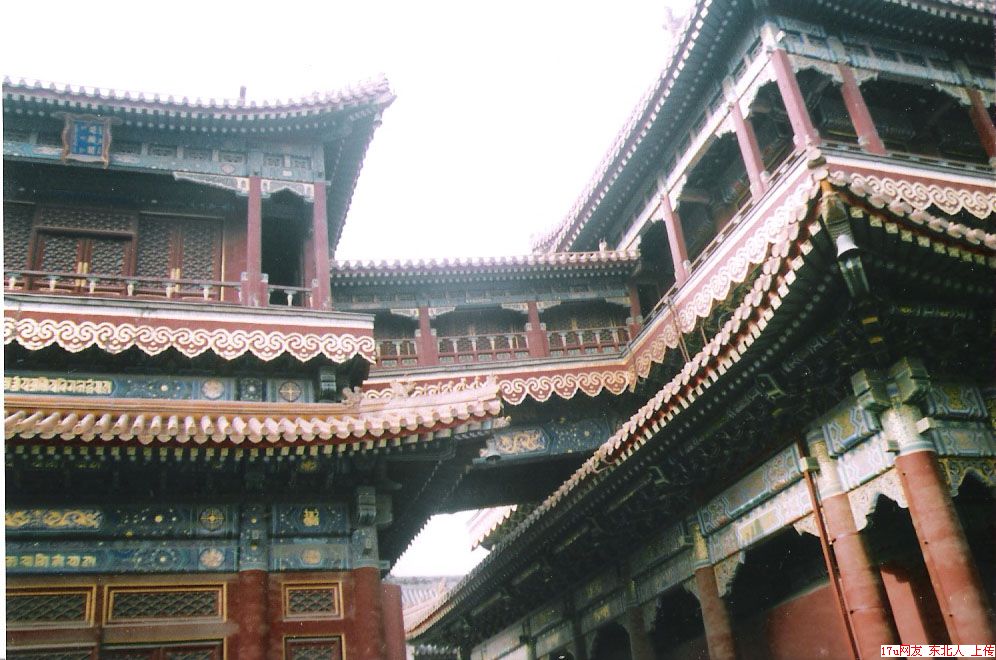
The palace was built in 1694 by Emperor Kangxi of the Qing as a residence for his son, Prince Yin Zhen. When the latter succeeded him to the throne in 1723, the new emperor moved into the Forbidden City, took the name Yong Zheng, and renamed his former residence the Palace of Harmony. He also had the green ceramic tiles replaced with yellow ones, the imperial color. In 1744, his successor, Emperor Qianlong, transformed the palace into a lamasery by offering it to Tibetan monks. In 1949, the Lama Temple was declared a national monument due to its historical importance.
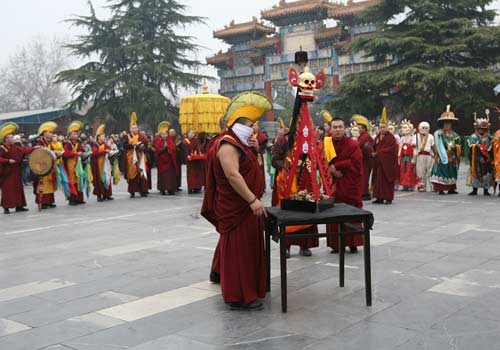
It survived the Cultural Revolution. In 1979, significant restoration work was undertaken, and monks from Inner Mongolia were invited to reside there. Tibetan and the secret liturgies of the Gelukpa order are studied there. The literal translation of Gelukpa is "model of virtue." Name of the reformed order of the most important Lamaist school in Tibet and Mongolia. It was founded in the 14th century by Tsongkhapa, a monk who intended to restore the ascetic ethics advocated by the historical Buddha. The ceremonial headdress of their dignitaries earned the Gelukpa the nickname "Yellow Hats" in the West. It is to this school that the great rinpoches such as the Dalai Lama belong.
Visit to the Lama Temple
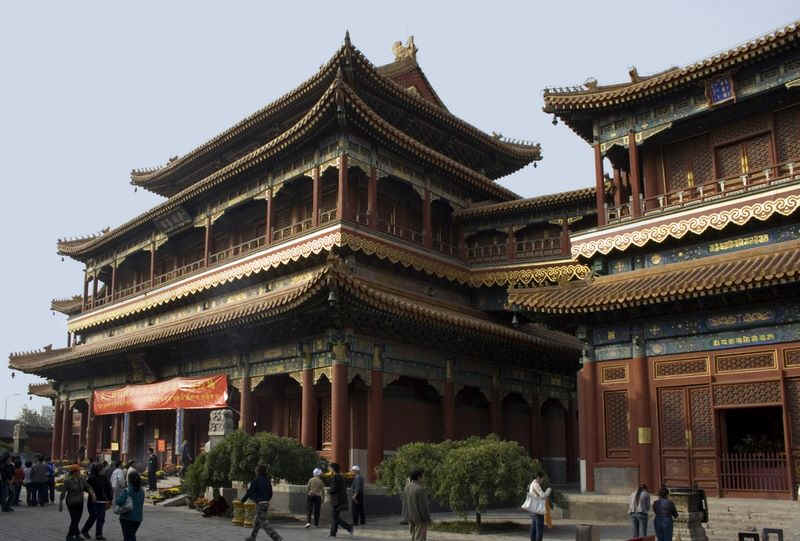
The Lama Temple consists of a crescendo of buildings accessed through a series of gateways.
The first gate is the Gate of Harmony (Yonghemen) in the Ming style with beautiful yellow and green glazed tiles.
The path then leads to two longevity pavilions inlaid with Buddhist symbols of long life: on the left, the Drum Pavilion, and on the right, the Bell Pavilion. We then arrive in a hall dedicated to Maitreya, the future Buddha in gilded wood, who welcomes the faithful at the entrance of the temple. According to Buddhism, the world is divided into four worlds protected by four guardians. Here, the four polychrome terracotta guardians crush the devils under their feet and protect Maitreya. Behind the latter is a sandalwood statue of Weituo, one of the guardians of Buddhism.
We exit behind Weituo and find ourselves in an inner courtyard with a central pavilion erected by Qianlong in 1792, which tells the story of the lamasery in Chinese, Manchu, Mongolian, and Tibetan. The incense burner in front of the stele dates back to 1748. On each side of the courtyard, we find halls dedicated to the study of Buddhist philosophy, medicine, esotericism, and mathematics.
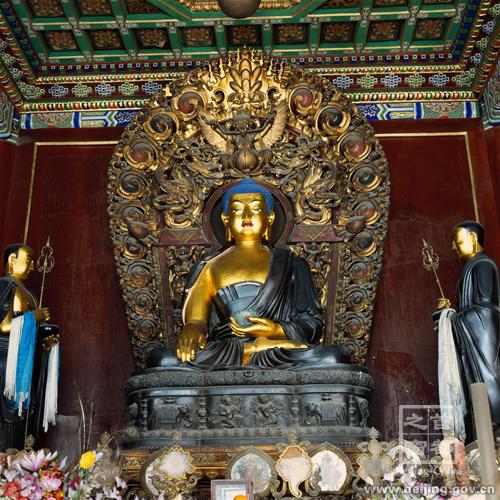
We then arrive at the Hall of Harmony (Yonghedian). It houses three bronze Buddhas who are the Buddhas of the past, present, and future. The bases are in the shape of a lotus, a symbol of purity: the lotus petals are covered with tiny wax beads that prevent mud from sticking to them, so even if the lotus grows in very dirty water, the flower always remains clean. The middle Buddha is surrounded by two disciples. In front are a perfume burner, a candelabra, and cloisonné enamel flower vases. On each side, nine arhats (= those who have reached the highest degree of wisdom) symbolize the military Buddha and provide protection. This hall also contains drums, prayer wheels, and beautiful tankas (stereotyped representations of Buddha).
We then exit and enter a courtyard with a four-faced bronze Buddha from Thailand.
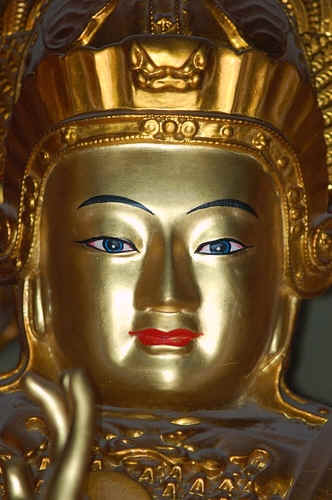
We then enter the Hall of Eternal Blessing, which was once the bedroom of Prince Yong Zhen. This hall now houses the three Buddhas of Longevity in the center, Medicine on the left, and the Lion's Roar (to scare away evil spirits) on the right. There are also two female Buddhas. The one on the left is made of 6000 pieces of sewn-together silk.
We pass through another courtyard and arrive at the Hall of the Wheel of the Law (Falun dian). This is the most spectacular hall in the monastery. It was built in 1694 and dedicated to Tsongkhapa (1357-1419), the founder of the reformed doctrine of the Yellow Hats (Gelukpa). Daily religious services are held here. In the center of the hall stands an immense statue of Tsongkhapa. This statue was cast in 1924. On the side walls of the temple, many scenes from his life are depicted. In front of the statue are the monks' seats. Behind, the wall of the 500 arhats represents the disciples who would have written down the sutras enunciated by Sakyamuni.
We pass through the last courtyard of the Lama Temple and arrive at the Pavilion of Ten Thousand Happinesses (Wanfu ge), built in 1750. This hall is also called the Tower of the Great Buddha. It indeed houses an immense statue of Maitreya, 26 meters high. It is carved from a single block of white sandalwood! It is a gift from the seventh Dalai Lama to Emperor Qiaonlong.
